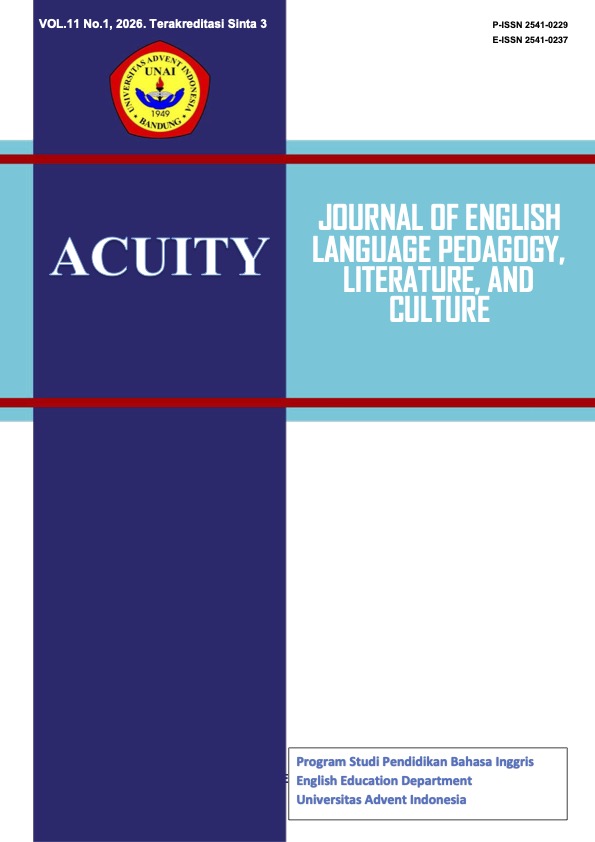Cultural Representations in Indonesian EFL Textbooks: A Synthesis Study
Keywords:
Cultural Representation, EFL Textbooks, Multicultural Education, Thematic SynthesisAbstract
This study aims to synthesize findings from eight qualitative research articles examining the representation of cultural content in English as a Foreign Language (EFL) textbooks used in Indonesia. The research is motivated by the increasing emphasis on intercultural competence in language education and the need to align textbook content with national character education and global communication goals. Although EFL textbooks are widely used in Indonesian classrooms as primary instructional materials, concerns have emerged regarding their cultural relevance and inclusivity. A thematic synthesis method was employed to analyze the selected studies, which focused on textbooks published or used in Indonesia between 2016 and 2025. The analysis consisted of three stages: coding primary findings, clustering them into descriptive themes, and synthesizing cross-study analytic themes. The findings reveal four major themes: the dominance of target cultures, superficial representation of cultural and multicultural values, cultural imbalance and bias, and the limited application of intercultural approaches. While some locally developed textbooks introduce Indonesian cultural content, they often fail to support deeper intercultural reflection and engagement. This study concludes that Indonesian English as a Foreign Language (EFL) textbooks need to be more culturally balanced and pedagogically reflective. Integrating intercultural competence into textbook design can better support learners’ linguistic development, national identity formation, and the development of global citizenship. The results necessitate a critical evaluation and revision of textbook content to ensure alignment with both national educational policies and intercultural communication objectives.
Downloads
References
Ariawan, S. (2020). Investigating cultural dimensions in EFL textbook by using Byram checklist. Register Journal, 13(1), 123–152. https://doi.org/10.18326/rgt.v13i1.123-152
Arslan, S. (2016). An analysis of two Turkish EFL books in terms of cultural aspects. Procedia - Social and Behavioral Sciences, 232, 217–225. https://doi.org/10.1016/j.sbspro.2016.10.049
Atiullah, K., Wuli Fitriati, S., & Rukmini, D. (2019). Using revised Bloom’s taxonomy to evaluate higher order thinking skills (HOTS) in reading comprehension questions of English textbook for year X of high school. English Education Journal, 9(4), 428–436. https://doi.org/10.15294/eej.v9i4.31794
Ayu, M. (2020). Evaluation cultural content on English textbook used by EFL students in Indonesia. JET (Journal of English Teaching), 6(3), 183–192. https://doi.org/10.33541/jet.v6i3.1925
Byram, M. (2020). Teaching and assessing intercultural communicative competence: Revisited. Multilingual Matters.
Hasnah, Y., Ginting, P., Saragih, M., Kharisma, A. J., & Sari, P. L. P. (2024). A probe into local cultural values in locally produced EFL textbooks in Indonesia. Humanities, Arts and Social Sciences Studies, 24(3), 648–661. https://doi.org/10.69598/hasss.24.3.268564
Inaroh, I., Faridi, A., & Wuli Fitriati, S. (2021). The use of structures and functions of lexical bundles in conversation texts in Bahasa Inggris Textbook published by Kemendikbud. English Education Journal, 11(1), 105–113. https://doi.org/10.15294/eej.v11i1.43411
Javadi, Y., & Tahmasbi, M. (2020). Application of sociocultural identity theory to education in EFL textbooks development. Theory and Practice in Language Studies, 10(5), 536. https://doi.org/10.17507/tpls.1005.07
Kailola, T. W. (2017). Intercultural exposure through English for foreign language coursebook : A Closer Look at English in Mind students book 3. Magister Scientiae, 2(42), 176–194. https://doi.org/https://doi.org/10.33508/mgs.v2i42.1725
Kramsch, C. (1993). Context and culture in language teaching. Oxford University Press.
Kurt, H. Ç., & Cinkara, E. (2025). Unearthing the traces of CEFR’s mediation in EFL textbooks in Türkiye. Acuity: Journal of English Language Pedagogy, Literature, and Culture, 10(1), 40–71. https://doi.org/10.35974/acuity.v10i1.3040
Lim, Y. (2020). An analysis of primary school English textbooks for integrative cultural competence. Journal of Research in Curriculum & Instruction 2020, 24(2), 1–7. https://doi.org/10.24231/rici.2020.24.2.1
Monib, W. K., & Hadi, H. ur R. (2025). Determinant factors influencing English speaking skill among undergraduates: Challenges and remedial strategies. Acuity: Journal of English Language Pedagogy, Literature, and Culture, 10(1), 72–85. https://doi.org/10.35974/acuity.v10i1.3351
Mustofa, M. I., & Martina, F. (2019). The analysis of cultural content in two EFL textbooks used at SMA IT Iqra’ and SMKN 1 Bengkulu City. Journal of English Education and Teaching, 3(4), 481–493. https://doi.org/10.33369/jeet.3.4.481-493
Nurarifah, L., Imah, N. ’, Putri, R. A., & Hardiyanti, M. (2025). Improving English speaking through media in the digital age. Acuity: Journal of English Language Pedagogy, Literature, and Culture, 10(1), 1–10. https://doi.org/10.35974/acuity.v10i1.3107
Richards, J. C. (2001). The role of textbooks in a language program. Cambridge University Press.
Septiana, E., Mujiyanto, J., & Sutopo, D. (2020). Teachers’ perception, plan, implementation, and evaluation toward the use of super minds textbook in EFL classroom. English Education Journal, 10(3), 321–330. https://doi.org/10.15294/eej.v10i1.36705
Setyono, B., & Widodo, H. P. (2019). The representation of multicultural values in the Indonesian Ministry of Education and Culture-Endorsed EFL textbook: A critical discourse analysis. Intercultural Education, 30(4), 383–397. https://doi.org/10.1080/14675986.2019.1548102
Sulistiyo, U., Wulan, R., Al Arif, T. Z. Z., Efriza, D., & Anwar, K. (2021). A critical content analysis of English textbook for senior high school students in Indonesia. Studies in English Language and Education, 8(1), 84–98. https://doi.org/10.24815/siele.v8i1.16778
Susan, S., Warsono, W., & Faridi, A. (2020). The evaluation of the compatibility of exercises between the revised Bloom’s taxonomy and the 2013 curriculum is reflected in the English textbook. English Education Journal, 10(2), 252–265. https://doi.org/10.15294/eej.v10i1.35742
Thomas, J., & Harden, A. (2008). Methods for the thematic synthesis of qualitative research in systematic reviews. BMC Medical Research Methodology, 8. https://doi.org/10.1186/1471-2288-8-45
Tomlinson, B. (2012). Materials development for language learning and teaching. Language Teaching, 45(2), 143–179. https://doi.org/10.1017/S0261444811000528
Zakiyah, Y., & Rukmini, D. (2022). Cultural contents on new step-up: Reading and writing for university students. English Education Journal, 12(1), 113–120. https://doi.org/10.15294/eej.v12i1.51090
Zein, S., Sukyadi, D., Hamied, F. A., & Lengkanawati, N. S. (2020). English language education in Indonesia: A review of research (2011–2019). Language Teaching, 53(4), 491–523. https://doi.org/10.1017/S0261444820000208

















